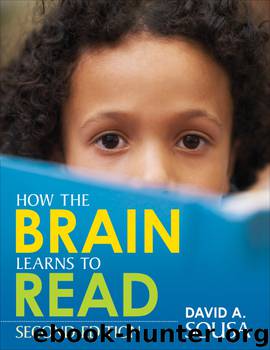How the Brain Learns to Read by David A. Sousa

Author:David A. Sousa
Language: eng
Format: epub
ISBN: 9781483333953
Publisher: SAGE Publications
Published: 2014-12-16T16:00:00+00:00
Nonlinguistic Causes
Some people, who are otherwise unimpaired, have extreme difficulties in reading because of deficits in auditory and visual perception not related to linguistic systems. This revelation was somewhat of a surprise because conventional wisdom held that impairments in reading (and also in oral language) were restricted to problems with linguistic processing. The following are some possible nonlinguistic causes found in the research literature.
Perception of Sequential Sounds
The inability to detect and discriminate sounds presented in rapid succession seems to be a common impairment in individuals with reading and language disorders. These individuals also have difficulty in indicating the order of two sounds presented in rapid succession. This particular deficit is related to auditory processing of sound waves in general and is not related directly to distinguishing phonemes as part of phonological processing. Hearing words accurately when reading or from a stream of rapid conversation is critical to comprehension (Wright, Bowen, & Zecker, 2000).
Sound-Frequency Discrimination
Some individuals with reading disorders are impaired in their ability to hear differences in sound frequency. This auditory defect can affect the ability to discriminate tone and pitch in speech. At first glance, this may seem like only an oral language–related impairment. However, it also affects reading proficiency because reading involves sounding out words in the auditory processing system (Wright et al., 2000). A longitudinal study showed that children who had problems with pitch discrimination as newborns had more difficulties than typical children when learning to read. This was especially evident for children in the study with a family history of dyslexia (Leppänen et al., 2010).
Detection of Target Sounds in Noise
The inability to detect tones within noise is another nonlinguistic impairment that seems to affect learning to read. These students have difficulty hearing the differences between tones and noise. This makes reading very challenging because the child’s language processing system cannot distinguish phonemic tones from all the incoming auditory information (Chait et al., 2007; Wright et al., 2000). When added to the findings in the two deficits mentioned above, this evidence suggests that auditory functions play a much greater role in reading disorders than previously thought. It also suggests that the evaluation of children who are having reading difficulties should include a thorough assessment of their auditory processing skills.
Visual Magnocellular-Deficit Hypothesis
The interpretation of some research studies has led to a hypothesis about the functions of the visual processing system. This proposes that certain forms of reading disorders are caused by a deficit in the visual processing system, which leads to poor detection of coherent visual motion and poor discrimination of the speed of visual motion. This part of the visual system involves large neurons and so is referred to as the magnocellular system. Impairment in this system may cause letters on a page to bundle and overlap, or appear to move—common complaints from some struggling readers and dyslexics. Current studies continue to show a strong correlation between deficits in the visual magnocellular system and developmental dyslexia (e.g., Laycock, Crewther, & Crewther, 2012). This correlation is also found
Download
This site does not store any files on its server. We only index and link to content provided by other sites. Please contact the content providers to delete copyright contents if any and email us, we'll remove relevant links or contents immediately.
| Administration | Assessment |
| Educational Psychology | Experimental Methods |
| History | Language Experience Approach |
| Philosophy & Social Aspects | Reform & Policy |
| Research |
The Art of Coaching Workbook by Elena Aguilar(50989)
Trainspotting by Irvine Welsh(21519)
Twilight of the Idols With the Antichrist and Ecce Homo by Friedrich Nietzsche(18503)
Fangirl by Rainbow Rowell(9097)
Periodization Training for Sports by Tudor Bompa(8170)
Change Your Questions, Change Your Life by Marilee Adams(7635)
This Is How You Lose Her by Junot Diaz(6795)
Asking the Right Questions: A Guide to Critical Thinking by M. Neil Browne & Stuart M. Keeley(5641)
Grit by Angela Duckworth(5523)
Red Sparrow by Jason Matthews(5390)
Paper Towns by Green John(5091)
Room 212 by Kate Stewart(5038)
Ken Follett - World without end by Ken Follett(4645)
Housekeeping by Marilynne Robinson(4347)
The Sports Rules Book by Human Kinetics(4294)
Double Down (Diary of a Wimpy Kid Book 11) by Jeff Kinney(4207)
Papillon (English) by Henri Charrière(4198)
The Motorcycle Diaries by Ernesto Che Guevara(4012)
Exercise Technique Manual for Resistance Training by National Strength & Conditioning Association(3956)
